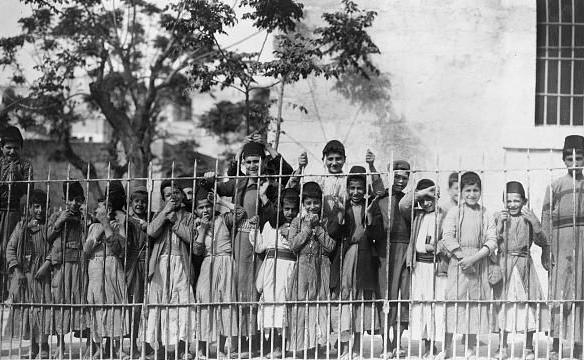
Arab-Israeli Conflict: Palestine (1900-14)

Figure 1.--The Carpenter Collection caption to this photograph read, "The boys of Nazareth are friendly, but in fanatical Nablus they throw stones at Christians" We are not sure about the religion of these boys, they could be either Christians or Muslim boys. Perhaps readers will know. We suspect they are a school group. We believe that the photograph was taken in the early-20th century, peraps the 1900s. The early 1920s, however, is posible. Source: Frank and Frances Carpenter Collection (Library of Congress). | |
Palestine until World War I was part of the Ottoman Empire. What we now refer to as Palestine is a fairly modern term which first began to be usused in the mid-19th century. European powers began to be concerned sbout the treatment of Christins in the Levnt, ibcluding Palestine. The arabs were a large minority in the Ottoman Empire. The Ottomans used both Christians and Jews to ofset the Arabs in their domains. The Ottomns granted Muslim, Christian, and Jewish communities to exercise jurisdiction over their own members through charters granted to them. This was standard Ottoman policy for centuries. Jews and Christians thus enjoyed a large degree of communal autonomy including matters like religion, personal status, taxes, and in managing schools and charitable institutions. Ottoman authorities regularized these charters as part of Tanzimat moderizatiom reforms (1856). As a result of Muslim Arab attacks on Christians and Jews, the European powers demanded better security arrangements for Chistians. Ottoman authorities were generally anxious to accomdate the Europeans to obtain diplomatic support to help fend off Russian incursions. This is often forgotten in the modern discussions of Palestine. There were very serious Muslim Arab attacks on non-Muslim communities before Zionist Jews began arriving in Palestine. The Christian Arab community was still sizeable in the Levant. Jews also benefitted from these protections. The Zionist movement in Europe organized the First Aliya in the late-19th century. The larger Second Aliyah followed in the early-20th century (1904-14). This included some 40,000 Jews, primarily from Russia and Poland (at the time mostly occupied by Russia). Tensions existed between the different comminities. This porimarily took the form of the majority Muslim Arabs attacking Christian Arabs, especially in aras like Nablus with strong Muslim majorities. The arrival of Zionist immigrants introduced larger numbers of Jews and more Muslims began to target Jews. This was, howver, mostly small-scale incidents. There was no reoccurance of the large scle attacks, primsrily because the Europeans had made it ckear that Arab Cristians were under their prorection. As Europe moved toward war, the security situation in Palestine did not change. The Ottoman Empire and Germany moved closer together against Britain and France, but Germany was one of the European powers which demanded that Ottoman authorities provide security arrangements for Chistians.
CIH

Navigate the Children in History Website:
[Return to Main Israel-Palestine 20th century page]
[Return to Main Israel-Palestine 21st century page]
[Return to Main Israel-Palestine page]
[About Us]
[Introduction][Biographies][Chronology][Climatology][Clothing][Disease and Health][Economics][Freedom][Geography][History][Human Nature][Law]
[Nationalism][Presidents][Religion][Royalty][Science][Social Class]
[Bibliographies][Contributions][FAQs][Glossaries][Images][Links][Registration][Tools]
[Children in History Home]
Created: 4:45 AM 8/6/2015
Last updated: 4:46 AM 8/6/2015



